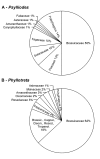Adaptation of flea beetles to Brassicaceae: host plant associations and geographic distribution of Psylliodes Latreille and Phyllotreta Chevrolat (Coleoptera, Chrysomelidae)
- PMID: 31293348
- PMCID: PMC6603994
- DOI: 10.3897/zookeys.856.33724
Adaptation of flea beetles to Brassicaceae: host plant associations and geographic distribution of Psylliodes Latreille and Phyllotreta Chevrolat (Coleoptera, Chrysomelidae)
Abstract
The cosmopolitan flea beetle genera Phyllotreta and Psylliodes (Galerucinae, Alticini) are mainly associated with host plants in the family Brassicaceae and include economically important pests of crucifer crops. In this review, the host plant associations and geographical distributions of known species in these genera are summarised from the literature, and their proposed phylogenetic relationships to other Alticini analysed from published molecular phylogenetic studies of Galerucinae. Almost all Phyllotreta species are specialised on Brassicaceae and related plant families in the order Brassicales, whereas Psylliodes species are associated with host plants in approximately 24 different plant families, and 50% are specialised to feed on Brassicaceae. The current knowledge on how Phyllotreta and Psylliodes are adapted to the characteristic chemical defence in Brassicaceae is reviewed. Based on our findings we postulate that Phyllotreta and Psylliodes colonised Brassicaceae independently from each other.
Keywords: Alticini; chemical plant defence; detoxification; glucosinolates; plant-insect interaction; secondary plant metabolites; sequestration.
Figures




Similar articles
-
A radiation of Psylliodes flea beetles on Brassicaceae is associated with the evolution of specific detoxification enzymes.Evolution. 2024 Jan 4;78(1):127-145. doi: 10.1093/evolut/qpad197. Evolution. 2024. PMID: 37919254
-
Biology, Ecology, and Management of Flea Beetles in Brassica Crops.Annu Rev Entomol. 2024 Jan 25;69:199-217. doi: 10.1146/annurev-ento-033023-015753. Annu Rev Entomol. 2024. PMID: 38270984 Review.
-
A new species of Phyllotreta Chevrolat, 1836 (Coleoptera: Chrysomelidae: Galerucinae: Alticini) from Omsk Province of Russia with comments on Phyllotreta species diversity in Northeastern Palearctic.Zootaxa. 2019 Oct 3;4679(3):zootaxa.4679.3.4. doi: 10.11646/zootaxa.4679.3.4. Zootaxa. 2019. PMID: 31715947
-
Susceptibility of brassicaceous plants to feeding by flea beetles, Phyllotreta spp. (Coleoptera: Chrysomelidae).J Econ Entomol. 2013 Dec;106(6):2557-67. doi: 10.1603/ec13102. J Econ Entomol. 2013. PMID: 24498758
-
How many genera and species of Galerucinaes. str. do we know? Updated statistics (Coleoptera, Chrysomelidae).Zookeys. 2017 Dec 11;(720):91-102. doi: 10.3897/zookeys.720.13517. eCollection 2017. Zookeys. 2017. PMID: 29290727 Free PMC article. Review.
Cited by
-
Past and current climate as a driver in shaping the distribution of the Longitarsus candidulus species group (Coleoptera: Chrysomelidae).J Insect Sci. 2024 Sep 1;24(5):2. doi: 10.1093/jisesa/ieae089. J Insect Sci. 2024. PMID: 39367725 Free PMC article.
-
Diversity and host plant utilization of leaf-mining beetles of Chrysomeloidea (Coleoptera) in Japan.Zookeys. 2025 May 16;1238:209-268. doi: 10.3897/zookeys.1238.124514. eCollection 2025. Zookeys. 2025. PMID: 40416424 Free PMC article.
-
Glucosinolate Abundance and Composition in Brassicaceae Influence Sequestration in a Specialist Flea Beetle.J Chem Ecol. 2020 Feb;46(2):186-197. doi: 10.1007/s10886-020-01144-y. Epub 2020 Jan 17. J Chem Ecol. 2020. PMID: 31953704 Free PMC article.
References
-
- Ameen AO. (1996) The biology and ecology of the yellow-margined leaf beetle, Microthecaochroloma Stål, (Coleoptera: Chrysomelidae) on crucifers. LSU Historical Dissertations and Theses. 6173: https://digitalcommons.lsu.edu/gradschool_disstheses/6173
-
- Antonini G, Audisio P, Biase AD, Mancini E, Rector BG, Cristofaro M, Biondi M, Korotyaev BA, Bon MC, Konstantinov A, Smith L. (2008) The importance of molecular tools in classical biological control of weeds: two case studies with yellow starthistle candidate biocontrol agents. In: Julien MH, Sforza R, Bon MC, Evans HC, Hatcher PE, Hinz HL, Rector BG. (Eds) Proceedings of the XII International Symposium on Biological Control of Weeds, La Grande Motte, France, 22–27 April 2007.C.A.B. International, Wallingford, Oxfordshire, UK, 263–269.
Publication types
LinkOut - more resources
Full Text Sources
